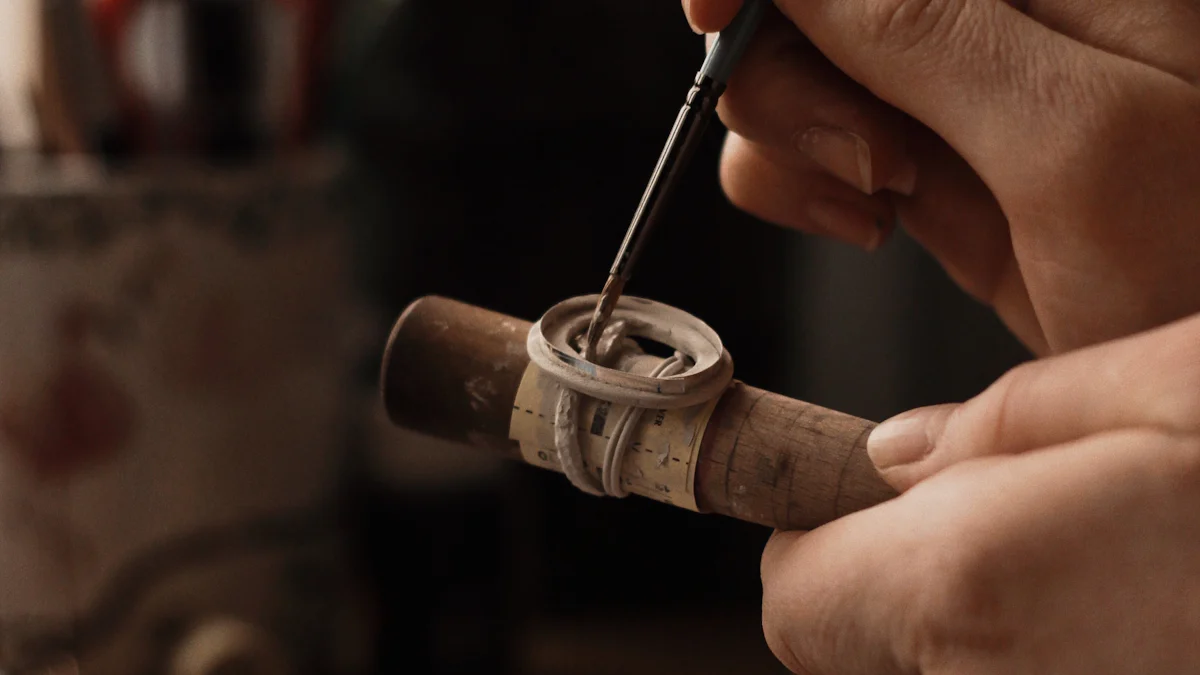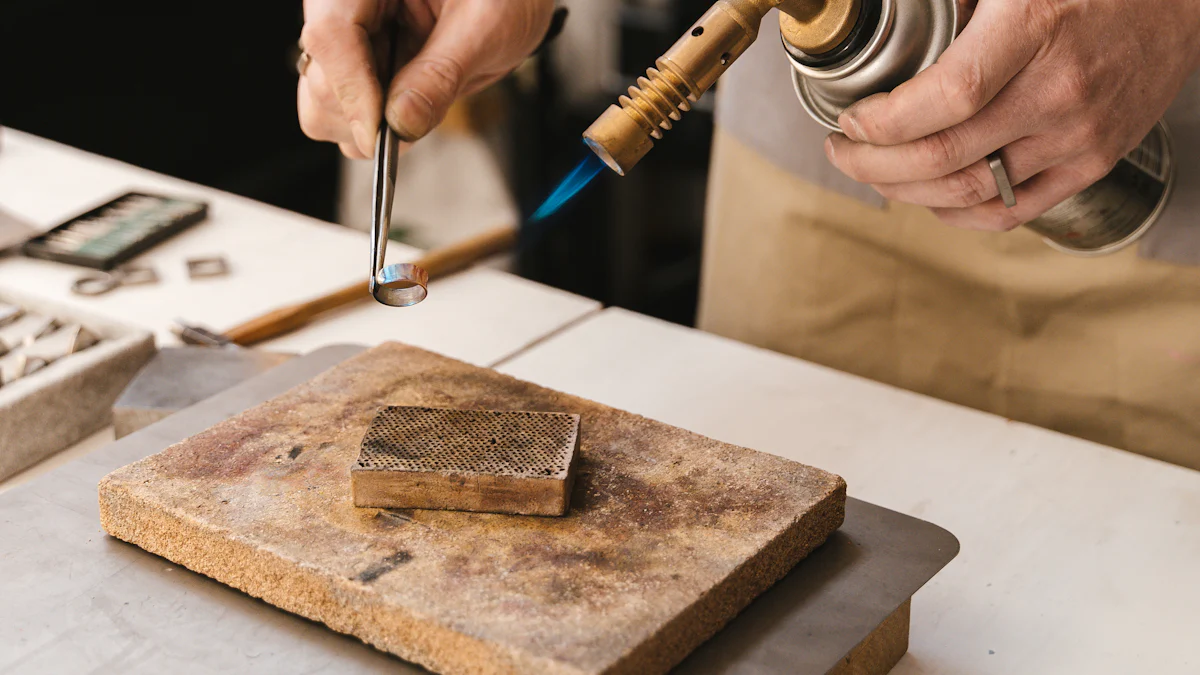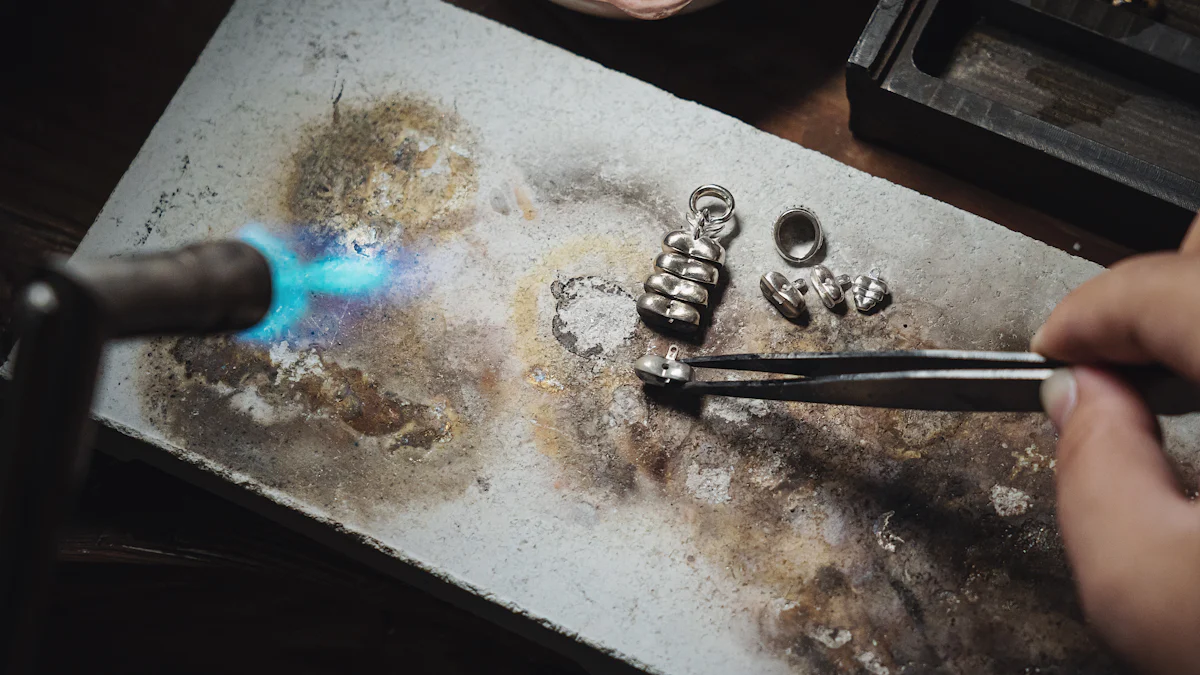Soldering Rings Made Simple for Beginners

Soldering rings can seem daunting, but it's a rewarding skill for any jewelry enthusiast. By mastering this technique, you unlock the ability to create custom pieces and repair your favorite rings. You'll find that soldering not only enhances your creativity but also saves money by allowing you to make adjustments at home. Remember to avoid lead solder for health reasons and opt for high silver content instead. If you're just starting out, consider watching YouTube tutorials to get a feel for the basics. Dive in and discover the joy of crafting your own beautiful jewelry!
Understanding Soldering Rings
What is Soldering?
Basic Definition
Soldering is a technique where you fuse metals by melting a filler metal, known as solder. This process creates a strong bond between the pieces. In jewelry making, soldering rings involves using a solder high in silver content, which ensures durability and safety. You avoid lead solder due to health risks.
Applications in Jewelry
In the world of jewelry, soldering rings allows you to join different metal pieces seamlessly. Whether you're working with silver, copper, or brass, soldering helps you create intricate designs and repairs. You can use techniques like sweat soldering and pick soldering to achieve various effects. This skill is essential for crafting unique and personalized jewelry pieces.
Benefits of Soldering Rings
Customization
Soldering rings opens up endless possibilities for customization. You can design rings that reflect your personal style or create meaningful gifts for others. By mastering soldering, you gain the ability to modify existing pieces or combine different elements into one cohesive design. This flexibility makes your jewelry truly one-of-a-kind.
Cost-Effectiveness
Learning to solder rings can save you money. Instead of paying for professional repairs or customizations, you can handle these tasks yourself. Investing in the right tools and materials, like soldering irons and flux, pays off in the long run. Plus, you enjoy the satisfaction of creating and maintaining your jewelry collection.
Tools and Materials Needed

To start soldering rings, you need the right tools and materials. Having these essentials will make your soldering experience smoother and more successful.
Essential Tools for Soldering Rings
Soldering Iron
A soldering iron is your primary tool. It heats the metal and melts the solder, allowing you to join pieces together. Choose a soldering iron with adjustable temperature settings. This feature helps you work with different metals and ensures precise control over the heat.
Solder
Solder acts as the glue that bonds your metal pieces. For jewelry, use a solder with high silver content. This type of solder provides strength and durability. Avoid lead-based solder due to health risks. You can find solder in wire or sheet form, depending on your preference.
Flux
Flux is a chemical cleaner that prevents oxidation during the soldering process. It helps the solder flow smoothly and creates a strong bond. Apply flux to the areas you plan to join. This step ensures a clean and effective soldering process.
Additional Materials
Safety Gear
Safety should always come first. Wear safety goggles to protect your eyes from sparks and fumes. Use heat-resistant gloves to shield your hands from burns. A well-ventilated workspace is also crucial to avoid inhaling harmful fumes.
Cleaning Supplies
After soldering, cleaning your work is essential. Use a pickle solution to remove any oxidation or residue from the metal. A soft brush helps scrub away any remaining debris. Finally, polish your ring to give it a shiny, professional finish.
By gathering these tools and materials, you set yourself up for success in your soldering journey. With practice and patience, you'll soon create beautiful, custom rings with ease.
Step-by-Step Guide to Soldering Rings

Preparation
Setting Up Workspace
Creating a safe and organized workspace is crucial before you start soldering. Choose a well-ventilated area to avoid inhaling fumes. Arrange your tools and materials within easy reach. A fireproof surface, like a soldering mat, protects your work area. Keep a small container of water nearby for emergencies. This setup ensures a smooth and safe soldering experience.
Cleaning the Metal
Clean metal surfaces are essential for a strong bond. Use a soft cloth or brush to remove dirt and oils. A mild detergent or specialized jewelry cleaner works well. Rinse thoroughly and dry completely. This step prevents impurities from interfering with the soldering process.
Soldering Process
Applying Flux
Flux plays a vital role in soldering. It cleans the metal and helps the solder flow. Apply a thin layer of flux to the areas you plan to join. Use a small brush for precision. This step ensures a clean and effective bond.
Heating the Metal
Heat the metal evenly with your soldering iron. Hold the iron close to the joint without touching it. Watch for the flux to bubble and turn clear. This indicates the metal is ready for soldering. Avoid overheating, as it can damage the metal.
Joining the Pieces
Place the solder on the joint once the metal is hot. The solder should melt and flow into the joint. Use tweezers to hold the pieces steady. Allow the solder to cool slightly before moving the ring. This step creates a strong and lasting bond.
Finishing Touches
Cooling and Cleaning
Let the ring cool naturally or dip it in water to speed up the process. Once cool, clean the ring with a pickle solution. This removes any oxidation or residue. Rinse thoroughly and dry with a soft cloth. This step restores the ring's shine.
Polishing the Ring
Polishing gives your ring a professional finish. Use a polishing cloth or wheel to buff the surface. Work in small circles for an even shine. This final touch enhances the ring's appearance and showcases your craftsmanship.
By following these steps, you can master the art of soldering rings. Practice regularly to improve your skills. Remember, patience and attention to detail are key. Enjoy the satisfaction of creating beautiful, custom jewelry pieces.
Common Concerns and Tips
Addressing Alignment Issues
Techniques for Proper Alignment
Getting your rings to align perfectly can be tricky. You might find that they don't sit flat or line up as you'd like. To tackle this, use a steady hand and some simple techniques:
Use a Jig: A jig holds your pieces in place while you work. It ensures everything stays aligned.
Check from Different Angles: Look at your work from various perspectives. This helps catch any misalignments early.
Practice with Scrap Metal: Before working on your final piece, practice with scrap metal. This builds confidence and skill.
Cost Considerations
Budget-Friendly Tips
Soldering doesn't have to break the bank. Here are some ways to keep costs down:
Start with Basic Tools: Invest in essential tools first. You can upgrade as you gain experience.
Buy Materials in Bulk: Purchasing solder and flux in larger quantities often saves money.
DIY Solutions: Create your own cleaning solutions using household items like vinegar and salt.
Achieving the Best Results
Practice and Patience
Soldering is a skill that improves with time. Here's how you can get better:
Regular Practice: Set aside time each week to practice. Consistency is key.
Experiment with Techniques: Try different soldering methods. Discover what works best for you.
Learning from Mistakes
Mistakes are part of the learning process. Embrace them:
Analyze What Went Wrong: Take a moment to understand any errors. This helps prevent them in the future.
Seek Feedback: Share your work with others. Constructive criticism can guide improvement.
Remember, soldering is both simple and complex. With patience and practice, you'll master it. Enjoy the journey of creating beautiful, custom jewelry!
Soldering rings offers you a world of creativity and practicality. You can customize jewelry, save money, and enjoy the satisfaction of crafting something unique. As you embark on this journey, remember that practice makes perfect.
Faye, a beginner, shared, "I'd really like to get into some basic soldering and make a simple ring for my girlfriend."
This shows how even simple projects can be meaningful. Explore online tutorials and join communities to enhance your skills. Dive in and enjoy the art of jewelry making!
See Also
Creating an Ideal Engagement Ring Dessert in Your Kitchen
Designing a Ring Cake: Step-by-Step Instructions
Comprehensive Manual for Selecting a Single Ring for Engagement and Marriage
Budget-Friendly Bridal Ring Packages: 5 Options
Selecting the Correct Finger for Your Marriage Band: A Manual

